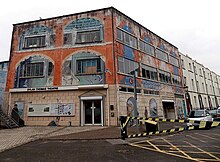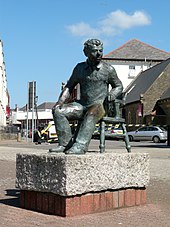Dylan Thomas
Dylan Marlais Thomas (27 October 1914 – 9 November 1953)[1] was a Welsh poet and writer, whose works include the poems "Do not go gentle into that good night" and "And death shall have no dominion", as well as the "play for voices" Under Milk Wood.
[20] Thomas wrote several poems about his childhood and early teenage years, including "Once it was the colour of saying" and "The hunchback in the park", as well as short stories such as The Fight and A Child's Christmas in Wales.
[30] A few fields south of Fernhill lay Blaencwm,[nb 7] a pair of stone cottages to which his mother's Swansea siblings had retired,[31] and with whom the young Thomas and his sister, Nancy, would sometimes stay.
[32] A couple of miles down the road from Blaencwm is the village of Llansteffan, where Thomas used to holiday at Rose Cottage with another Welsh-speaking aunt, Anne Williams, his mother's half-sister[33] who had married into local gentry.
His family had originated[38] in another part of Welsh-speaking Carmarthenshire, in the farms that lay around the villages of Brechfa, Abergorlech, Gwernogle and Llanybydder, and which the young Thomas occasionally visited with his father.
[39] His father's side of the family also provided the young Thomas with another kind of experience; many lived in the towns of the South Wales industrial belt, including Port Talbot,[40] Pontarddulais[41] and Cross Hands.
[48] He described his experience there in Reminiscences of Childhood: Never was there such a dame school as ours, so firm and kind and smelling of galoshes, with the sweet and fumbled music of the piano lessons drifting down from upstairs to the lonely schoolroom, where only the sometimes tearful wicked sat over undone sums, or to repent a little crime – the pulling of a girl's hair during geography, the sly shin kick under the table during English literature.
[62] Thomas continued with acting and production throughout his life, including his time in Laugharne, South Leigh and London (in the theatre and on radio), as well as taking part in nine stage readings of Under Milk Wood.
[73][74] In the Kardomah Café, close to the newspaper office in Castle Street, he met his creative contemporaries, including his friend the poet Vernon Watkins and the musician and composer, Daniel Jones with whom, as teenagers, Thomas had helped to set up the "Warmley Broadcasting Corporation".
[16] When "Light breaks where no sun shines" appeared in The Listener in 1934, it caught the attention of three senior figures in literary London, T. S. Eliot, Geoffrey Grigson and Stephen Spender.
However, an “unreliable lung”, as he described his chronic condition – coughing sometimes confined him to bed, and he had a history of bringing up blood and mucus – proved to be the grounds for the military authorities to allocate him a C3 category medical exemption which meant that he would be among the last to be called up for service.
[121] In July 1944, with the threat in London of German flying bombs, Thomas moved to the family cottage at Blaencwm near Llangain, Carmarthenshire,[122] where he resumed writing poetry, completing "Holy Spring" and "Vision and Prayer".
[123] In September that year, the Thomas family moved to New Quay in Cardiganshire (Ceredigion), where they rented Majoda, a wood and asbestos bungalow on the cliffs overlooking Cardigan Bay.
"[128] Walford Davies, who co-edited the 1995 definitive edition of the play, has noted that New Quay "was crucial in supplementing the gallery of characters Thomas had to hand for writing Under Milk Wood.
[143] He appeared in the play Comus for the Third Programme, the day after the network launched, and his rich, sonorous voice led to character parts, including the lead in Aeschylus's Agamemnon and Satan in an adaptation of Paradise Lost.
[169] Despite Cleverdon's urgings, the script slipped from Thomas's priorities and in January 1951 he went to Iran to work on a film for the Anglo-Iranian Oil Company, an assignment which Callard has speculated[170] was undertaken on behalf of British intelligence agencies.
He met the deadline only after being locked in a room by Brinnin's assistant, Liz Reitell, and he was still editing the script on the afternoon of the performance; its last lines were handed to the actors as they were putting on their makeup.
Summarising their findings, they conclude: "The medical notes indicate that, on admission, Dylan's bronchial disease was found to be very extensive, affecting upper, mid and lower lung fields, both left and right.
Thomas derived his imagery from sources which include the new scientific accounts of physiology and sexuality, the Bible, Welsh folklore, and Sigmund Freud as well as from the established literary canon.
[260] As Thomas wrote in a letter to Glyn Jones: "My own obscurity is quite an unfashionable one, based, as it is, on a preconceived symbolism derived (I'm afraid all this sounds wooly and pretentious) from the cosmic significance of the human anatomy”.
[261] Who once were a bloom of wayside brides in the hawed house And heard the lewd, wooed field flow to the coming frost, The scurrying, furred small friars squeal in the dowse Of day, in the thistle aisles, till the white owl crossed Distinguishing features of Thomas's early poetry include its verbal density, use of alliteration, sprung rhythm and internal rhyme, with some critics detecting the influence of the English poet Gerard Manley Hopkins.
[268][269][nb 21] Critics have explored the origins of Thomas's mythological pasts in his works such as "The Orchards", which Ann Elizabeth Mayer believes reflects the Welsh myths of the Mabinogion.
In 1951, in response to an American student's question, Thomas alluded to the formative influence of the nursery rhymes which his parents taught him when he was a child: I should say I wanted to write poetry in the beginning because I had fallen in love with words.
[272]Thomas became an accomplished writer of prose poetry, with collections such as Portrait of the Artist as a Young Dog (1940) and Quite Early One Morning (1954) showing he was capable of writing moving short stories.
[274] Not for the proud man apart From the raging moon, I write On these spindrift pages Nor for the towering dead With their nightingales and psalms But for the lovers, their arms Round the griefs of the ages, Who pay no praise or wages Nor heed my craft or art.
"[278] Head of Programmes Wales at the BBC, Aneirin Talfan Davies, who commissioned several of Thomas's early radio talks, believed that the poet's "whole attitude is that of the medieval bards."
'[291] In 1956, the publication of the anthology New Lines featuring works by the British collective The Movement, which included Amis and Larkin among its number, set out a vision of modern poetry that was damning towards the poets of the 1940s.
[288] The BBC Radio programme Desert Island Discs, in which guests usually choose their favourite songs, has heard 50 participants select a Dylan Thomas recording.
[295] Goodby also cites that, despite a brief period during the 1960s when Thomas was considered a cultural icon, the poet has been marginalized in critical circles due to his exuberance, in both life and work, and his refusal to know his place.
Goodby believes that Thomas has been mainly snubbed since the 1970s and has become "... an embarrassment to twentieth-century poetry criticism",[295] his work failing to fit standard narratives and thus being ignored rather than studied.









